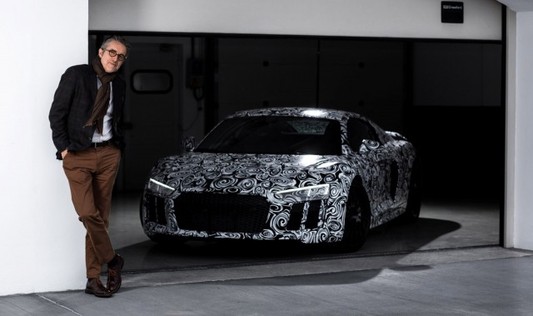Audi Releases First Specs For New R8 Supercar
Audi has now confirmed some of the specs for the upcoming car.

According to Heinz Hollerweger, the chief of Audi’s quattro performance division, which is responsible for Audi’s RS cars as well as the R8, the engineers have utilized more carbon fiber for the construction of the second-generation model. The lightweight stuff has been used for some of the body panels but also integrated into the vehicle structure to add stiffness and remove weight. The final curb weight is approximately 3,200 pounds or about 145 lbs less than the previous model.
Another important change involves the standard quattro all-wheel-drive system, which now offers a fully variable distribution of torque between the front and rear axles (up to 100 percent to either end) thanks to a new electro-hydraulically operated multi-plate clutch. There is also a new electronic power steering system instead of the previous hydraulic setup.
In the engine department, Audi will offer the new R8 initially with a range-topping V-10. A V-8 option will be added later, along with an all-electric e-tron variant and possibly a new plug-in hybrid variant. This is in contrast to the strategy utilized for the previous R8, which was launched with a V-8 and had its V-10 variant added later in the life cycle.The V-10 engine destined for the new R8 is the same 5.2-liter unit found in Lamborghini’s Huracán, a car that shares its platform with the new R8 albeit has a smaller footprint and is a bit lighter. Peak output of the engine is capped at 601 horsepower and 413 pound-feet of torque, which is the same rating for the Huracán LP 610-4. The only transmission for the new R8 is a seven-speed S tronic dual-clutch unit.
Inside the car, designers have implemented Audi’s Virtual Cockpit concept where lesser-used functions are consolidated to touch screens, controller clicks, or voice commands, and some more frequent functions move to steering-wheel toggles to clear up the dash. Vital info is presented via a 12.3-inch display located in the main instrument cluster. The screen is highly configurable and can present information such as lateral acceleration, various driving modes and tire pressure.
Another important change involves the standard quattro all-wheel-drive system, which now offers a fully variable distribution of torque between the front and rear axles (up to 100 percent to either end) thanks to a new electro-hydraulically operated multi-plate clutch. There is also a new electronic power steering system instead of the previous hydraulic setup.
In the engine department, Audi will offer the new R8 initially with a range-topping V-10. A V-8 option will be added later, along with an all-electric e-tron variant and possibly a new plug-in hybrid variant. This is in contrast to the strategy utilized for the previous R8, which was launched with a V-8 and had its V-10 variant added later in the life cycle.The V-10 engine destined for the new R8 is the same 5.2-liter unit found in Lamborghini’s Huracán, a car that shares its platform with the new R8 albeit has a smaller footprint and is a bit lighter. Peak output of the engine is capped at 601 horsepower and 413 pound-feet of torque, which is the same rating for the Huracán LP 610-4. The only transmission for the new R8 is a seven-speed S tronic dual-clutch unit.
Inside the car, designers have implemented Audi’s Virtual Cockpit concept where lesser-used functions are consolidated to touch screens, controller clicks, or voice commands, and some more frequent functions move to steering-wheel toggles to clear up the dash. Vital info is presented via a 12.3-inch display located in the main instrument cluster. The screen is highly configurable and can present information such as lateral acceleration, various driving modes and tire pressure.
